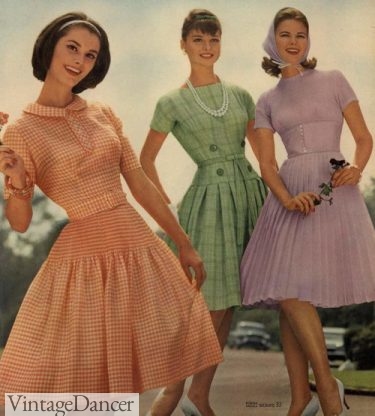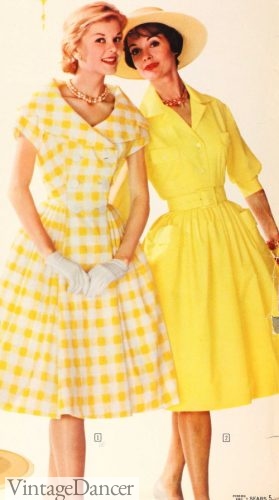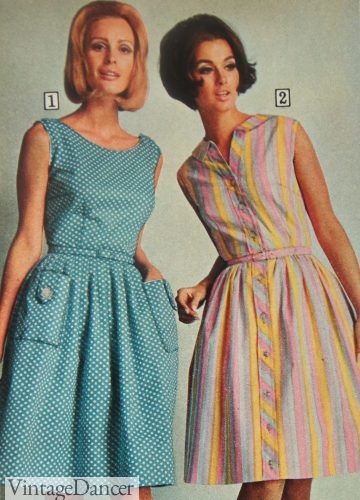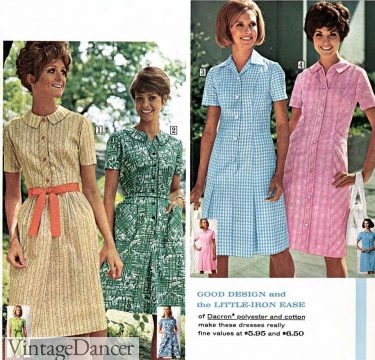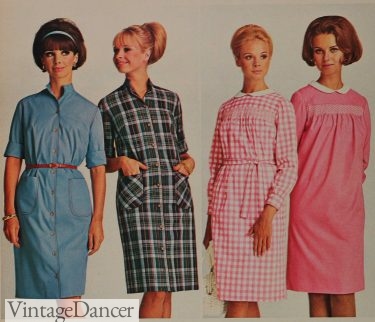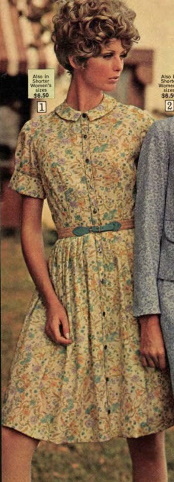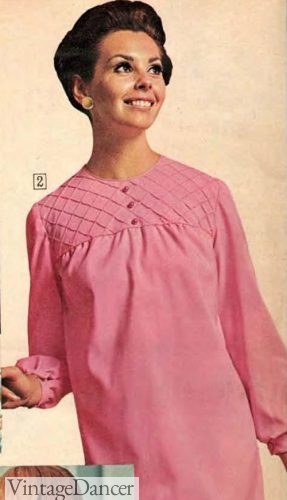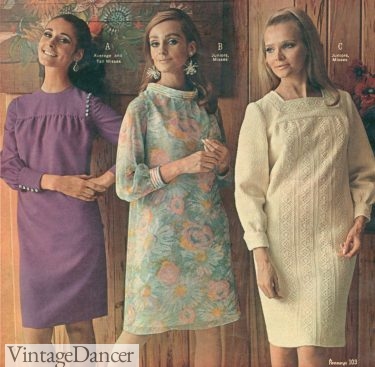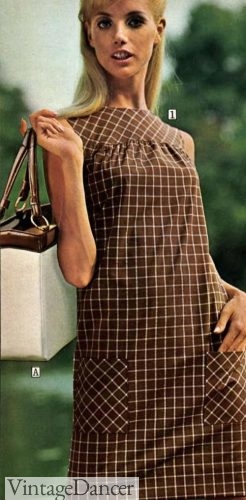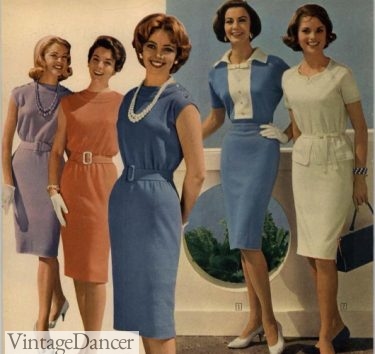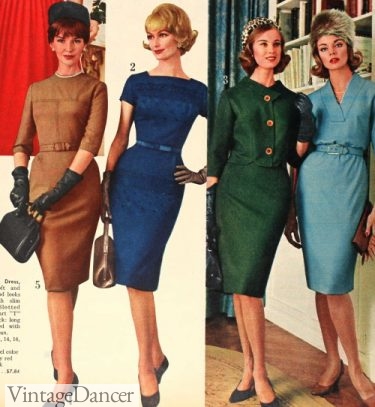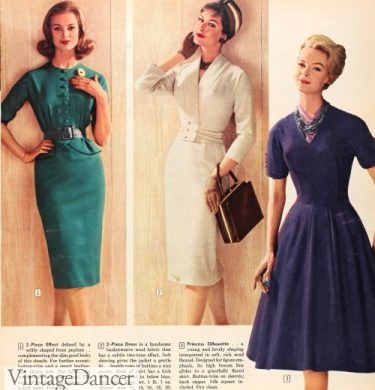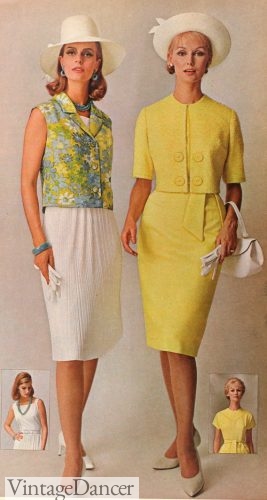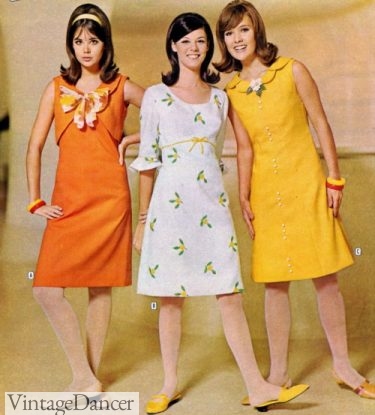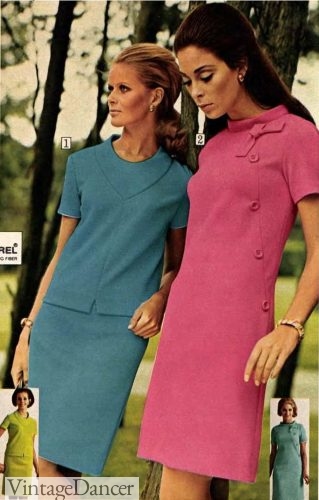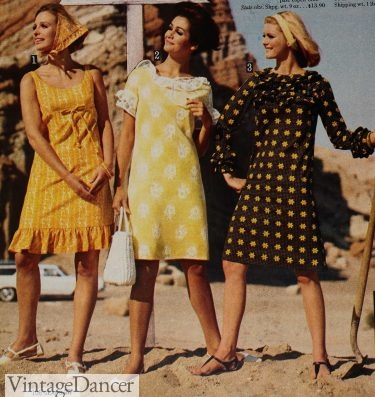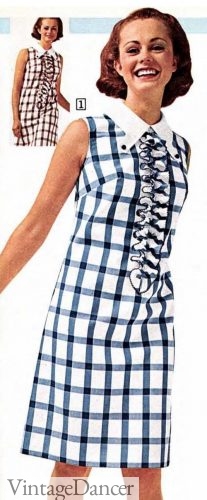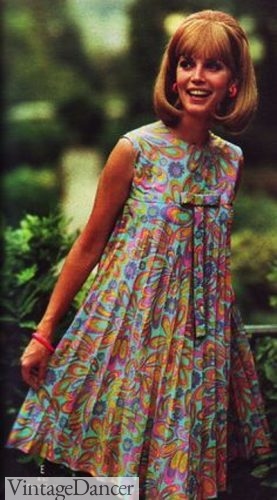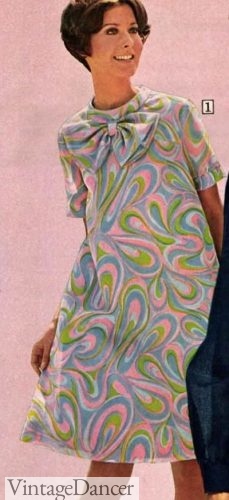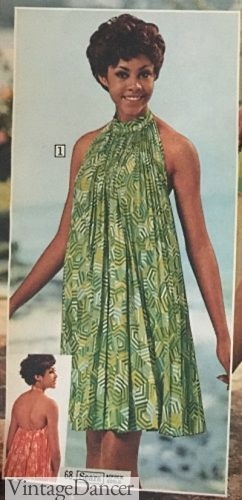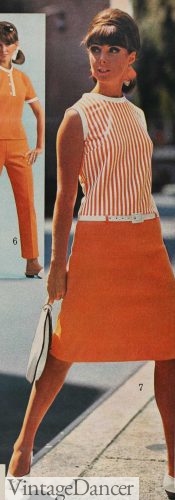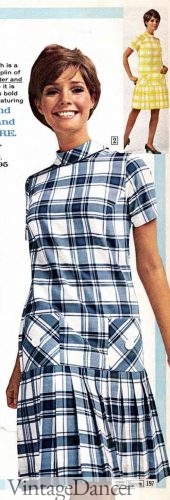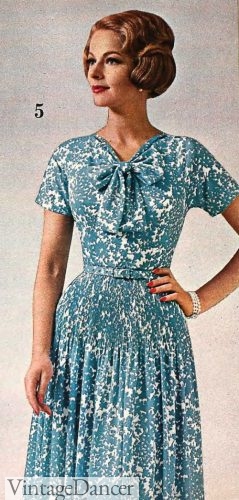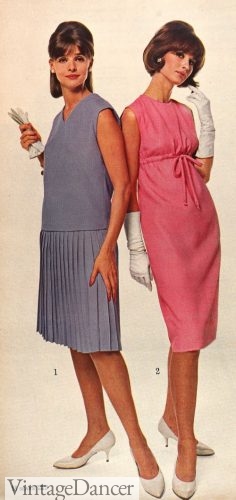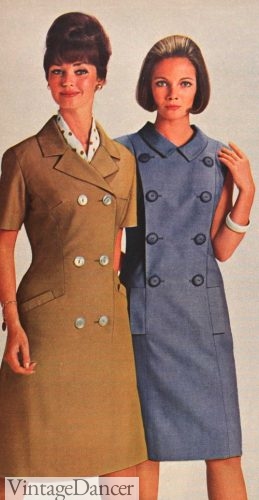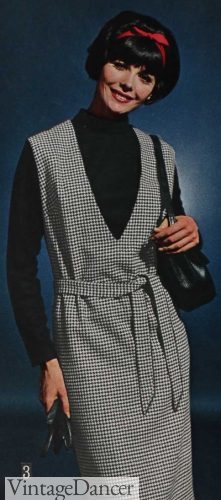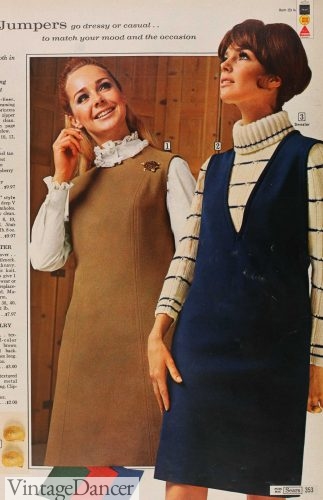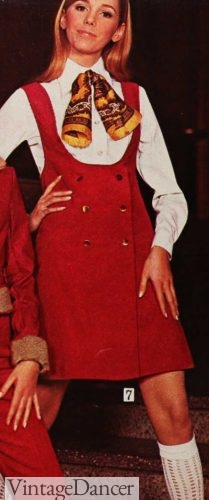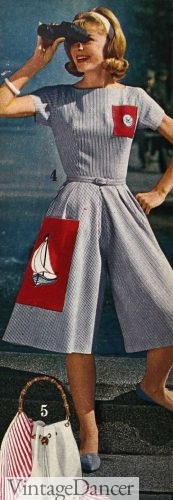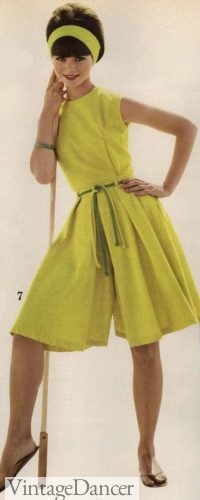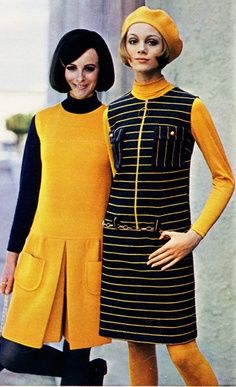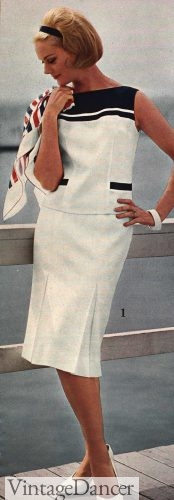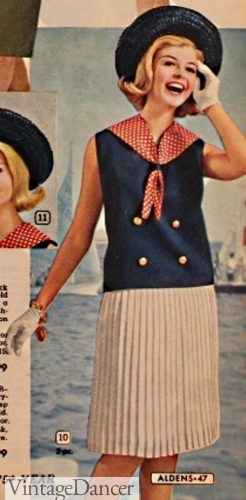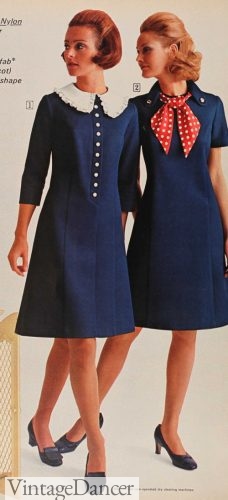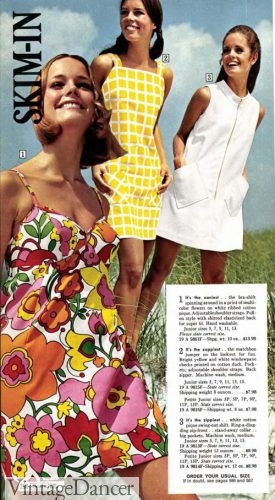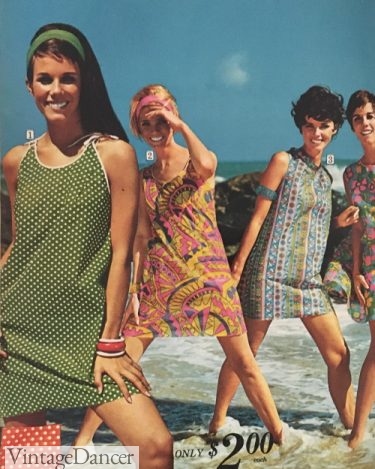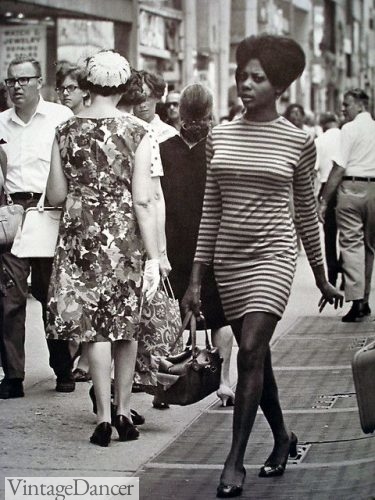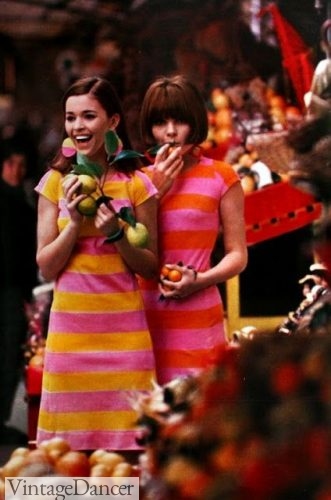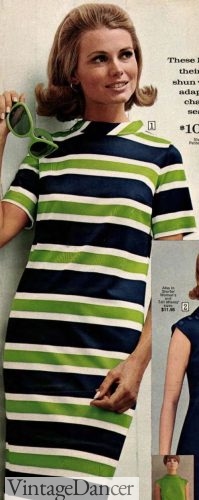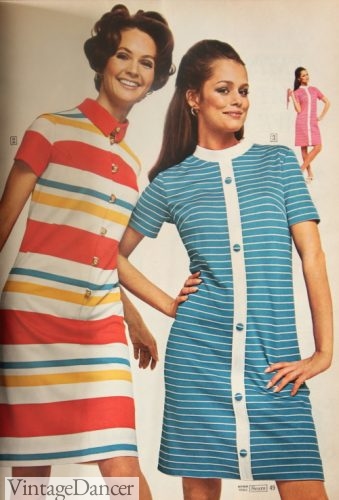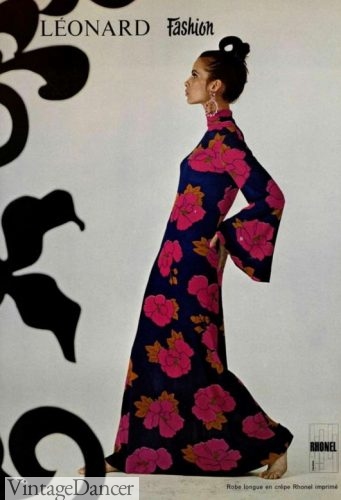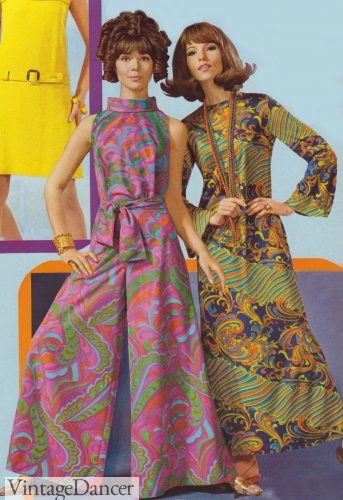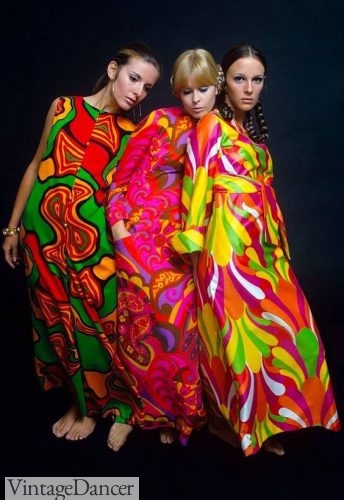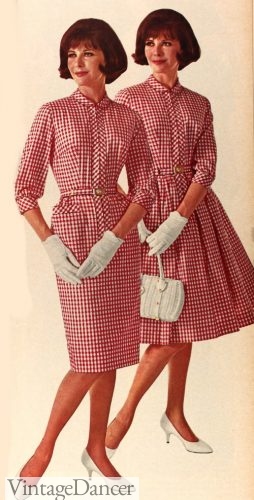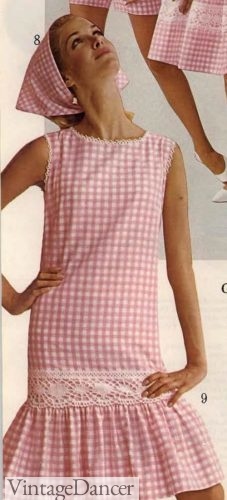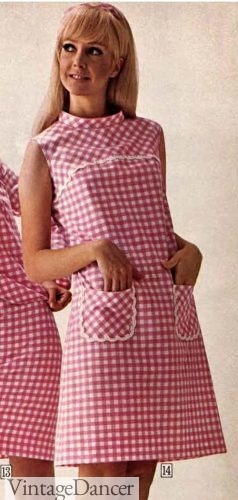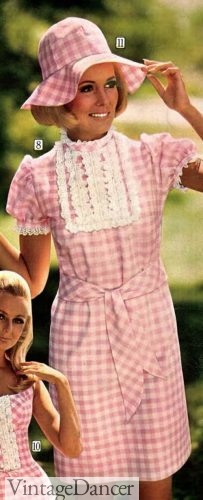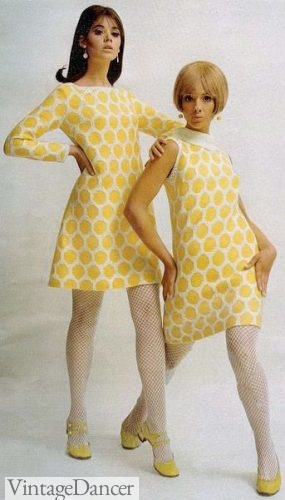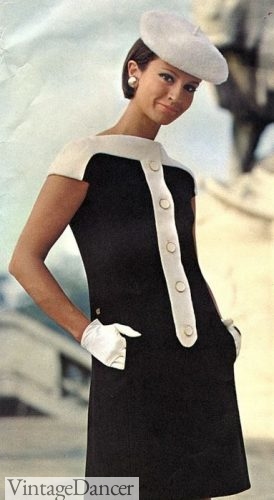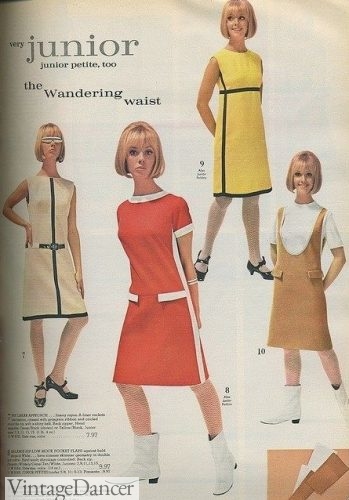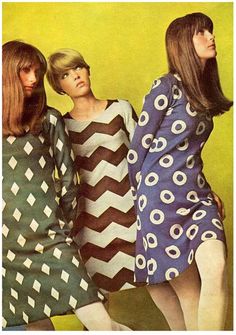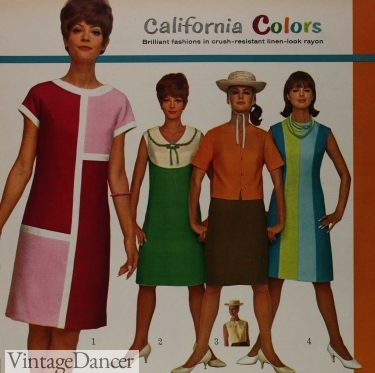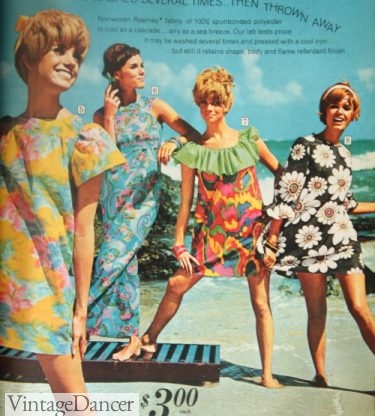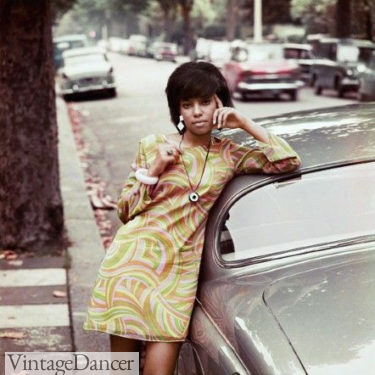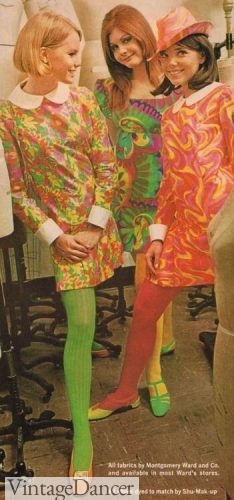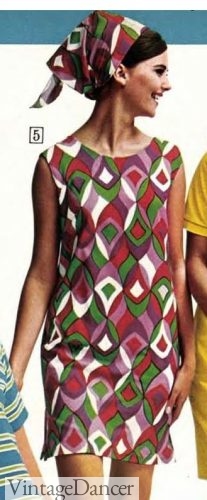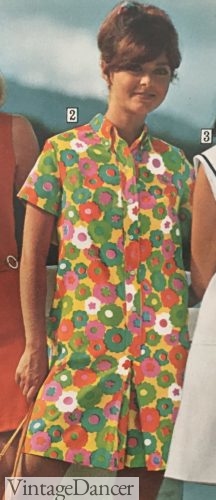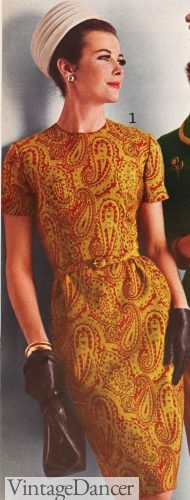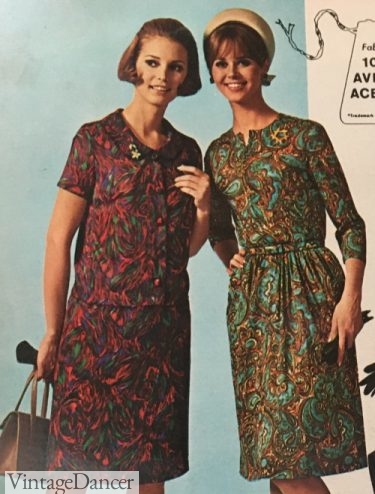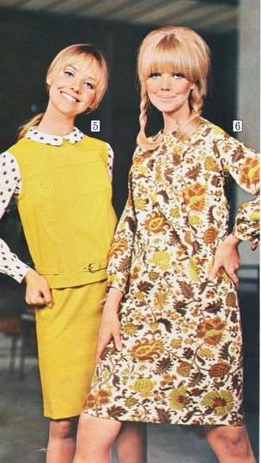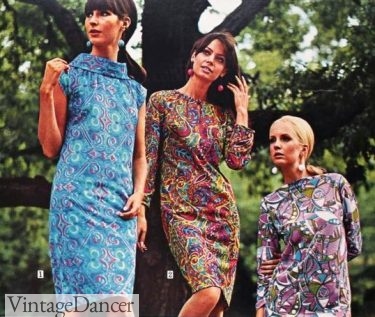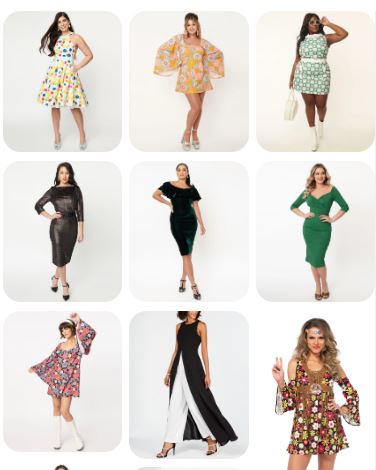Breaking free from the tailored look on the 1950s, the youthquake driven dresses of the sixties loosed up the waistline, shorted the hemline and hit you smack in the face with bright Pop Art colors and Op Art (optical illusion) prints. 1960s dresses had multiple style variations off of one key shape- the shift dress. From there, a new decade of dress designs began to experiment with waistline placements, sleeve shapes, colors, and patterns.
Follow along as I show you all the 60s dress styles worn by real people in the 1960s (mostly American, but these styles apply to all western dress).
Skip over the history and start shopping for a 1960s dress.
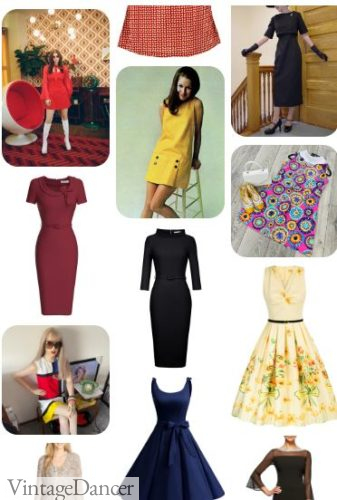
Shop 60s style dresses
1960s Dress Styles
Swing Dresses
The full skirt and tight bodice of the ‘50s swing dress continued in the early ’60s, with a slightly above or at the knee hemline and modest high necklines. 60s swing dress colors and patterns were bigger and brighter with high necklines and short cap sleeves or the new-ish 3/4 sleeve. Round collarless necklines, small Peter Pan collars, roll neck collars, and the wide portrait collar were frequently seen on swing dress tops.
- 1961 drop waist swing dresses
- 1960 portrait collar check and classic collar swing dresses
- 1963 paisley swing dress or Fit n’ Flare dress
- 1968 swing dresses
1960s dress skirts became less full, requiring only a slip instead of crinoline petticoat as the decade moved on. Big box pleating made some skirts look fuller. Jackie Kennedy was seen wearing a box pleat swing skirt with bow belt, which became very trendy for a few years.
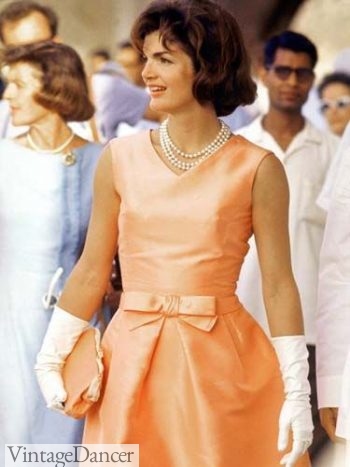
Jackie O – so classy!
By 1965 the swing dress almost disappeared, only to come back again in 1969 with a mini skirt length.
Shirtwaist Dress – Housewife Dress
Most swing dresses in the 1960s were deemed house dresses or housewife dresses, especially in the shirtwaist design. 1960s shirtwaist dresses that buttoned down the front from neck to waist, mid way down the skirt, or all the way to the hemline had been traditional house dresses since the 1920s. Plaid, checks, gingham, and vertical stripes were very popular patterns. Shirtwaist dresses had classic point collars or the newer round Peter Pan collar.
At some point the “waist” part of shirtwaist was dropped and they simply became know as “shirt dresses.” Shop shirt waist or shirt dresses in vintage styles.
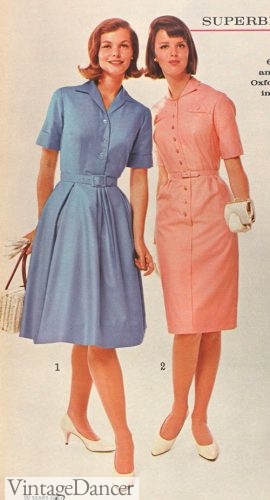
1964 shirtwaist swing and pencil dresses
By the mid 60s the shirtwaist dress was updated into the “step in” shirtwaist dress which was a button down skimmer dress tightened with an optional thin tie belt.
- 1969 shirtwaist house dresses
- 1966 house dress, shirtwaist and smocked shifts
- 1965 plaid or stripe shirtwaist dresses
- 1968 paisley shirtwaist dress with peterpan collar
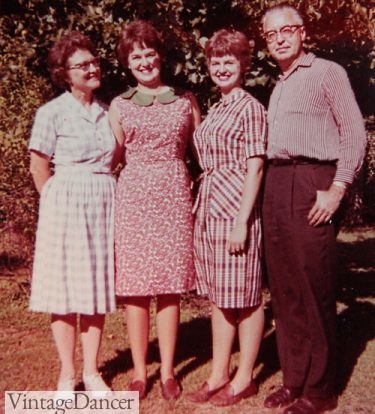
My family in the early 60s (grandma, aunt, mom, grandpa)
Smock Dresses
The smock top skimmer dress with a line above the bust and sometimes “smocking” or shirred details was another late 60s house dress design. These adorable dresses were inspired by nostalgic prairie life/Old West/ frontier days but with the short 60s hemline. They were mostly seen on women’s house dresses but some designers made them work as party dresses. They were not very popular however, and the trend quickly faded.
- 1968 pink smock dress
- 1967 smock party dresses (R and L)
- 1968 smock house dress
Shift, Sheath, Skimmer, Tent Dresses
The other 50s to 60s dress carry over was the contoured sheath dress, called a pencil or wiggle dress today. Like the 50s version, it was knee-length, modest, and minimalist but gently tailored to the hourglass curve of the body. Knit fabrics were the best materials to use in the 1960s so that women could have the “wiggle dress” shape without the confines of stiff suiting.
- 1961 knit pencil dresses
- 1962 pencil dresses
The 1960s two piece sheath dress looked like a fitted jacket with a pencil skirt. It was a very classy! As the sheath dress loosened up into the shift dress the two piece dress followed with a short sleeve shell top and looser pencil skirt.
- 1960 two peice pencil dresses
- 1963 two piece sheath dresses
The 60s shift dress lacked any sort of tailored waistline but did pinch in slightly around the ribs and skimmed over the hips, ending slightly above the knee. Some had belts, most did not. This loose but narrow looking dress was very comfortable and easy to wear. The shift became the primary women’s 1960s dress style.
- 1966 shift dresses
- 1968 simple shift dresses
Skimmer dresses were a cousin of the shift dress. They fit straight on the body with a high neckline and minimal decoration. The dress “skimmed” the body without touching the skin. They also hovered above the knee. The ruffle front skimmer was very trendy between 1968-1970.
Shift, sheath, and skimmer dresses were used interchangeably in sixties advertising, adding some confusion to dress style names.
- 1966 skimmer dress with “old west” touches
- 1969 ruffled front skimmer dress
The 60s tent dress was the widest fitting loose dress. Later decades called it a babydoll or swing dress (not the same as an early 60s swing dress). Pleats handing from the neckline or shoulders down in a wide A-line gave the dress movement, hence the “swing” name. The wide flare and the bowtie at the neck or bust miniaturized young women, making them look like dolls instead of grown women.
- Pleated paisley tent dress
- 1968 swirls tent dress
- 1968 green tent dress
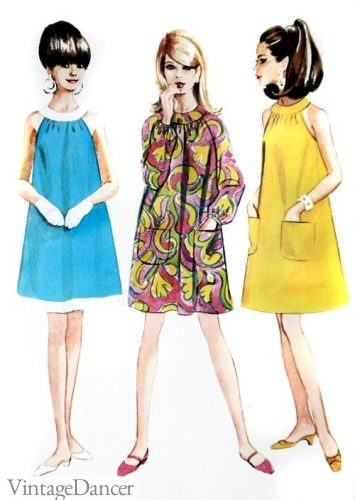
1966 tent dresses
1960s Drop Waist Dresses
The 1960s has some unique waistline treatments that were revivals from earlier decades, primarily the 1920s.
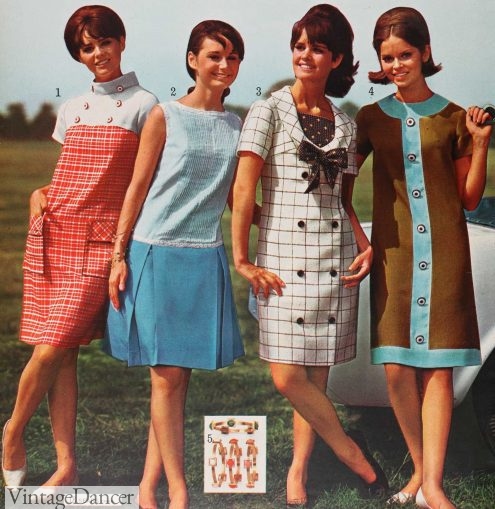
1966 dresses: Skimmer, A-line, Coachman, Shift Dresses
The A-line dress, like the other shapeless 60s dress above, had a relaxed fit up top but a A shaped flared skirt below. It could be one color but often had a different pattern or color top and bottom making it look like a skirt set. Paired with a drop waist it was a 60s “young look” dress.
Other drop waist dresses had pleated skirts to mimic the A-line flare. They were a favorite with young and mature women, but mature women’s pleated skirt dresses look like those from the 1940s.
- 1966 A-line dress
- 1969 drop waist plaid dress
- 1963 classic pleated skirt drop waist dress
Instead of the low drop waist there was also a revival for the high empire waist dress. The dress top cut of just below the breasts and skimmed over the torso. Sometimes a drawstring tie made the empire effect – a very cute and charming “girly” detail.
- 1963 drop waist and empire waist dresses
- 1966 trippy empire waist dress
- 1964 coachman dresses
The coachman dress was an updated name for the coat and dress. It could have a sheath or shift dress shape topped with a double row of either decorative or functional vertical buttons.
Jumper or Pinafore Dress
Going with the “little girl” look of the 1960s, the jumper dress or pinafore dress was worn by girls, teens, and some women. There were several neckline treatments from the high and modest shift dress to the V neck sheath dress and the very late 60s deep U shaped jumper dress. They were a casual winter dress worn over a blouse or turtleneck shirt, usually white or cream, sometimes black.
- 1964 hounds tooth tie waist V jumper dress
- 1968 high neck and V neck jumpers
- 1969 deep U jumper dress
- 1969 plaid jumper dress
1960s Summer Dresses
Coulotte Dress
The Coulotte short pant was a trendy style for summer. With a fitted top and extra wide legs, the Coulotte looked like a dress. They fit more into the “playwear” or summer “sporty” looks rather than dress wear, but the cross-over was noticeable. Many house dresses adopted the comfortable Coulotte as well as summer vacation clothes.
- 1962 nautical themed Coulotte dress
- 1962 Coulotte dress
- Coulotte jumper dress
The nautical or sailor theme had been and remains to be a popular summer trend. Red, blue and white stripes with sailboat, nautical flags, anchor motifs, accented by brass buttons, white “sailor” collars, and polka dot neck scarves. They made their way onto all kinds of summer clothing and dresses from casual to classy. Taking a vacation or sailing on a cruise almost required women to purchase these outfits.
Shop vintage sailor / nautical outfits.
- 1963 white dress with blue accents
- 1964 pleated skirt dress with sailor tops
- 1969 navy dresses with nautical accents
Sun Dresses
At the end of the decade, young women and teens started wearing sleeveless sundresses. The lack of sleeves wasn’t a new thing to 60s fashion, but the spaghetti straps were. Add to it a built in bra (for B cup sizes) and you have a fun beach-y casual summer dress. For those not quite ready to show off that much cleavage, there were other slip-over lightweight summer dresses in festive prints.
- 1969 bra cup sun dress
- 1968 summer slip over dresses
1960s Stripe Knit Dresses
Vertical stripes had been common in all parts of the 1960s but horizontal stripes, especially in bold mod colors and jersey knit fabrics, were the trendiest look for teens and young women with the body to pull them off. They were casual 60s dresses, comfortable in nearly any weather, and most important to the sixties, FUN!
- New York street scene. Woman in a stripe knit dress
- 1966 striped mod dresses (Jours de France )
- 1968 stripe knit pullover dress
- 1968 stripe knit shirt dresses
Hostess Dress
What about long dresses? Were all dresses in the 1960s short?
Yes and no. Almost all women’s dresses were at or above the knee. Women wore tights or tall socks to beat the cold, but fashion was fashion and fashion said no long dresses! There was one exception. The hostess gown.
In the late 1950s and early 1960s, party dresses were split down the center skirt and worn over a pair of capri or long pants becoming a hostess gown. In the late 1960s, a revival of the hostess gown idea happened, combining the long house robe with an ethnic dashiki or caftan inspired tunic dress. Ethnic inspired prints, large florals, geometric patterns, and psychedelic swirls splattered across these unusual gowns. They were considered a novelty and few regular women adopted but in wealthy and famous circles they thing to wear at lavish house parties… or simply to lounge at home in.
- Flower print hostess gown
- 1968 paisley print jumpsuits and hostess gown
- Psychedelic print hostess dresses
Gingham Dresses
Brigitte Bardot wore a pink gingham wedding dress with white lace trim in 1959 . After that, pink gingham was used for all kinds of dresses. Other pastel gingham colors such as purple, blue, yellow, and green were also trendy but not nearly as cute as pink. White lace or rick rack trim added to the girlishness of the gingham dress.
The trend didn’t phase out either. The gingham dress surged back in the late 60s just as strongly as the early years.
- 1964 red gingham pencil and swing dress
- 1965 pink gingham drop waist dress
- 1968 smock top gingham dress
- 1969 pink gingham with lace trim
Read more: 1960s Colors and Fabrics in Women’s Fashion
Mod Dresses
Colors and prints were at first inspired by the pop art and modern art movements, AKA “Mod” culture. Checkerboard, wide stripes, windowpane, circles, honeycomb, zig zags, and Campbell’s soup cans were all placed on short shift dresses with contrasting white trim. Black and white dresses were especially MOD. In fact, any two or three colors placed in square or rectangle color blocks with black or white outlines were distinctly mod, inspired by Dutch artist Piet Mondrian.
- Honeycomb Mod Print Dresses
- Bold White on Black Mod Art
- Black or white contrasting trim
- White minimal trim
- Geometric prints
- Color blocking
Trippy Prints
Psychedelic swirls and prints introduced a trippy edge to clothing that was picked up by the hippies around 1966-1968. As early as 1963, there were yellow daisy print dresses for women, not just teens.
Being over the top was never too much. Large paisley swirls, neon flower daisies, and tropical beach prints all made an appearance. Bright yellow, orange, hot pink, and lime green were the favorite colors.
- 1968 trippy sun dresses
- 60s Psychedelic Swirls
- Swirling trippy colors
- 1968 abstract geometric print
- 1963 trippy yellow flowers
- 1968 mod daisy flower print
- 1968 soft daisy flowers
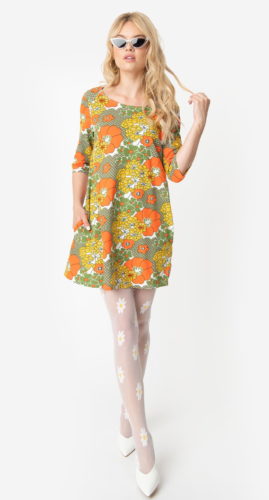
60s-70s Flower Power Dress with Daisey Tights. Shop here.
Paisley
The bright psychedelic colors were great for summer but out of place in the autumn. The solution was the paisley print.
The paisley print in earth tone colors of moss green, brown, mustard yellow, deep blue, and burnt orange were common colors in the cool seasons. They allowed women to dress in the bold patterns they already loved but on a toned-down, office friendly, scale.
Paisley was also worn in summer in light pastels and trippy psychedelics.
- 1963 yellow and orange paisley sheath dress
- 1967 fall paisley print dresses
- 1967 yellow, brown and white paisley dress
- 1967 all season paisley dresses
Shop 1960s Style Dresses
To complete your look, add a pair of 1960s flat shoes and colorful jewelry. For all you dress makers, look at these 1960s reproduction sewing patterns.
Debbie Sessions has been teaching fashion history and helping people dress for vintage themed events since 2009. She has turned a hobby into VintageDancer.com with hundreds of well researched articles and hand picked links to vintage inspired clothing online. She aims to make dressing accurately (or not) an affordable option for all. Oh, and she dances too.
